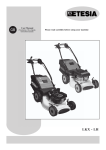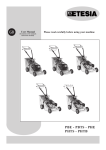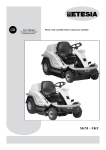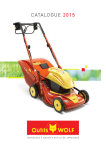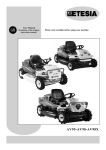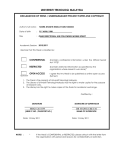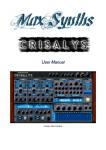Download User Manual Please read carefully before using your machine
Transcript
GB User Manual (Translation of the originals instructions manual) Please read carefully before using your machine AK 51 Contents AK 51 Brush-cutter 1. Your safety and that of others........................................................................................................................................................ 3 2. Key to diagrams............................................................................................................................................................................. 5 3. Descriptions................................................................................................................................................................................... 7 4. Pictures.......................................................................................................................................................................................... 8 5. Technical specifications................................................................................................................................................................. 9 6. Preparation and getting started.................................................................................................................................................... 10 7. Operating instructions.................................................................................................................................................................. 11 8. Maintenance................................................................................................................................................................................. 12 9. Winter storage - long stop............................................................................................................................................................ 13 10. Day to day maintenance – Breakdowns and solutions................................................................................................................ 14 11. Regular maintenance summary.................................................................................................................................................... 14 12.Warranty....................................................................................................................................................................................... 15 Y ou are now the proud owner of an Etesia brush-cutter! You have just bought an ETESIA machine. This amazingly strong and reliable machine has been designed to last. • In order to increase its service life and ensure optimum operation, please read this instruction booklet very carefully and make sure you follow the safety and maintenance instructions. • ETESIA has a policy of continuously improving the quality of its products. • Therefore, your machine might show slight differences compared with the description in the present booklet. • Your ETESIA dealer is in possession of the most recent technical specifications. • Do not hesitate to contact him. INTRODUCTION • Before you use the machine, read the instructions for use thoroughly, paying particular attention to the advice concerning your safety and that of others. • Keep this manual in a safe place for later consultation. • This semi-professional brush-cutter is intended only for cutting grass and other small shoots on ground which is relatively uniform and averagely maintained, where a lawnmower is no longer totally satisfactory. • It is not a lawn mower and consequently it should not be used for the regular mowing of your lawn. • Any use other for cutting grass and small shoots is not in compliance with the instructions and is not recommended. 1• Your safety and that of others User responsibility Before using your brush-cutter • Familiarise yourself with its controls. • Clear the field of stones, pieces of wood or metal, wire, bones, plastic, branches and other debris liable to be thrown up by the brush-cutter. • Low branches liable to cause injury to the user should also be removed. • Before using the machine, always check the condition and the adjustment of the blade. • Loose clothing and short trousers should not be worn when using the machine. • Always wear stout, closed and non-slip shoes. Your safety and that of others • The brush-cutter must be used according to the instructions in this manual. • Children under the age of 16 and people not familiar with the use of the brush-cutter, must not use it. • Never let anyone who has not read the instruction manual use the brush-cutter. • Never drive your brush-cutter too close to embankments or ditches, or on soft ground or where there is a risk of overturning. • Never operate the brush-cutter when you are feeling tired or unwell, or after consuming alcohol or taking medicine. • The user is responsible for ensuring the safety of others within the area where the brush-cutter is being used. • Whilst using the brush-cutter, ensure no injury can be caused to others by stones and other objects being thrown up. • Keep a safe distance from people, especially children, and animals when the engine is running. • Never remove warning labels or safety devices. • The machine must be equipped with its three safety flaps. • Never place hands or feet under the cutter housing. • Keep your hands or feet clear of rotating or moving parts. • Avoid obstacles such as mole hills, tree stumps, concrete pedestals and edging which cannot be cut by the blade and which could damage the cutting system. • Change absolutely the blade after any shock. • Operate the brush-cutter only in daylight or with good artificial lighting. • Respect the minimum safety distance given by the side bars of the handle. • When using the brush-cutter on slopes, be particularly careful, and take great care when changing direction. • Avoid working on slopes that are too steep (see picture 1- page 8). WARNING! Never allow the engine to run in a confined space. Exhaust gases contain carbon monoxide which is odourless and can kill. • Never close the choke flap when the engine is running or when it is hot. • Never leave the brush-cutter unattended with the engine running. • Stop the engine for any maintenance on the brush-cutter. • The blade clutch and drive lever should never be blocked in the working position. • If the brush-cutter has to be lifted or transported, stop the engine. • As a precaution, disconnect the spark plug. • When moving the brush-cutter off the ground to be cut, stop the blades rotating or switch off the engine. • You should also comply with any legal requirements relating to the use of machines equipped with internal combustion engines. • These precautions are vital to your safety. • However, the recommendations given are not exhaustive and due care should always be exercised when using your brush-cutter. MAINTENANCE AND STORAGE • Always maintain the brush-cutter and accessories in perfect working condition. • Never start cleaning or servicing the brush-cutter before stopping the engine. • As a precaution, disconnect the spark plug. • Always use recently purchased petrol. • Old petrol will leave gum deposits in the carburettor, which can cause leaks and make the engine difficult to start. • Only buy as much unleaded petrol as required for one month’s use and store it in a clean can designed for this purpose. WARNING! Fuel is highly flammable. • NEVER STORE, POUR OR USE PETROL NEAR A NAKED FLAME or near devices such as stoves, water heaters with pilot lights or any other devices liable to produce sparks. • Never fill the fuel tank in a closed or insufficiently ventilated area. • Only fill the tank in the open air and DO NOT SMOKE during this operation. • Fill the tank before you start the engine. 3 1• Your safety and that of others • Never remove the fuel tank cap whilst the engine is running or hot. • Allow the engine to cool for few minutes before filling. • Ensure that the fuel tank and fuel can caps are replaced correctly. • If fuel is spilt, if you smell petrol or if there is any risk of explosion, do not attempt to start the engine. • Remove the brush-cutter from the area where the fuel was spilt and take care not to ignite any undispersed fuel vapour. • Do not transport the brush-cutter with fuel in the tank or when the fuel cock is open. • Do not modify the regulator springs, rods and others parts to increase the engine speed. • Let the engine run at the recommended speed. • Do not check the spark by removing the spark plug. • Use an approved checking system. • Do not pull the starter when the spark plug is removed. • If the engine is flooded, bring the gas lever to ‘maxi’ and pull the starter until the engine starts. • Do not knock the engine flywheel with a hammer or hard object as it may cause the flywheel to break during use ; all major servicing should be performed by an authorised ETESIA workshop which has the appropriate tools for engine maintenance. • Never use the engine without its silencer. • Check it regularly and change it if it is damaged or leaking. • Do not risk burning yourself by touching the exhaust pipe, the cylinder or fins. • Never use your brush-cutter in wooded areas, brush or on fallow or grassy ground if the exhaust pipe is not fitted with a spark arrester (The spark arrester must be kept in good condition by the user or owner). • Do not start the engine when the air filter or its cover is removed. • To prevent the engine from starting accidentally, remove the spark plug cap during all servicing operations. • Clean the cylinder fins and regulator mechanism of any dirt, grass residue or other materials which could affect the engine speed. • Pull the starter cord slowly until you feel a resistance. • Then pull it energetically to prevent recoiling and hurting your hand or arm. • Check the fuel piping and connections for cracks and leaks. • Have them changed if necessary. • Spare blades must only be fitted to the machines for which they are designed, and in accordance with the instructions provided. • Use only genuine ETESIA spare parts. • The use of inferior quality parts may damage the engine. 4 RESPONSIBILTY • No responsibility will be accepted by ETESIA in the event of failure to comply with this manual or with current regulations. • Never modify your brush-cutter without the prior approval of ETESIA. • Unauthorised modifications could prove dangerous and result in serious injury to the user. • No responsibility will be accepted by ETESIA in the case of failure to comply with these instructions. IDENTIFICATION OF THE MACHINE • The serial number of your brush-cutter is on the identification label. • Always give this number to your ETESIA workshop for any maintenance operations. • You will only be ready to use this brush-cutter after you have read carefully all the safety instructions. • Read this instruction manual completely before using and servicing your machine. 2• Key to diagrams - SAFETY Safety labels LABEL A a. CAUTION ! b. Before using, please read and follow the safety and maintenance instructions of the instruction booklet LABEL B This symbol appears in the instruction manual alongside those sections which deal with user safety. c. Finger cut risks d. Stop the engine, disconnect the spark plug before proceeding any services on the mower This symbol appears in the instruction manual alongside important information on how to prolong the life of your mower. LABEL C e. Risk of projected objects f. Keep the third person away from the machine A B C 5 2• Key to diagrams - USE • Engine speed • Drive control lever START position: to start with cold engine Maximum run - To move forward, push the control lever against the handlebar. - To stop, release the control lever. • blade clutch control lever STOP position: to stop the engine • SPEED CONTROL LEVER BLADE 1 - Press the upper safety lever against to the handlebar. 2 - Push the button and move the blade clutch control lever forward to engage the blade. BLADE Forward speed 3 Forward speed 2 - Release the safety lever to stop blade rotation. The blade will be automatically braked and stopped. • Differential lock Forward speed 1 - Set the differential lock control lever to position [1]. - Bring the differential lock control lever back to position [0] to return to the active differential configuration and gain in handling capability. Reverse drive speed 6 3• DESCRIPTIONS 3 2 4 17 6 9 10 10 10 5 1 14 11 12 15 8 13 16 7 7 • 1. Drive lever • 2. The blade clutch • 3. Gas lever • 4. Speed selector lever • 5. Differential lock lever • 6. Blade safety lever • 7. Cutting height adjustment levers (x4) • 8.Handle adjustment nut-bolts • 9. Blade • 10. Safety flaps (x3) • 11.Oil sump filler and drain cap • 12.Fuel tank cap 10 • 13.Fuel cock • 14. Starter • 15. Air filter • 16. Spark plug • 17. By-pass valve control lever ACCESSORIES • Blade • Spark plug • Twin wheel kit : TZ 51 A : 03861 : 42698 7 4• PICTURES MAXI 20° 1 4 2 5 3 8 6 5• TECHNICAL Specifications Engine KAWASAKI FC180V OHV - 4 strokes with differential lock Piston displacement 182 cm3 Stroke 50 mm Bore 68 mm Maximum power measured at the shaft output 6 CV (4,42 kw) at 3600 tr/min Rate 3000 rpm StarterRecoil Decompression device Mechanical RegulatorMechanical Tank capacity 2,5 l FuelUnleaded fuel Oil SAE 10W30 or SAE 15W40 (0,65l) CarburetorFloat type, main fixed jet Cooling Air cooled Air filter Paper cartridge and prefilter IgnitionElectronic Spark plug Standard Ø 14 mm Thread lenght : 19 mm Electrode gap 0,75 mm Blade clutch device Belt Cutting width 51 cm Cutting height 50 - 65 - 80 - 95 - 110 mm ; 5 position on each wheel Blade clutch belt tension Whell diameterFront : Ø 225 mm Rear : Ø 310 mm Drive speed hydraulic gearboxForward1 : 0 - 3,0 Forward2 : 0 - 4,0 Forward3 : 0 - 5,0 kph/gbox Reverse : 0 - 4,0 kph Weight 85 kg Blade ETESIA Reference TZ 51 A Vibration level at the handle Reference standard for measurements : EN 836, EN 1033, Ahw < 2,5 m/s2 Sound pressure at driver’s seat Reference standard for measurements : EN 836 Lpa = 79dB (A) 9 6• Preparation and getting started • Bring the handlebars back to the working position. • Swing the locks to abut against the handlebars and tighten the nutknobs. The handlebar can be adjusted in 3 positions. • Unscrew the nut-bolts (1 picture 2 page 8) and clear the nuts from the handlebar. • Hold the top of the handlebar and swivel it towards the front of the mower. • Using two 13 mm spanners, loosen the 2 swivel bolts (item a picture 2 page 8) of handlebar retaining triangles and move them into the desired position (3 positions are possible), then tighten them again. • Bring the handlebar in its new retained position against the handlebar and tighten the nut-bolts (item b picture 2 page 8). PREPARATION OF THE ENGINE – OIL - FUEL • For transport-related reasons, the engine sump does not contain oil. • Before you start the engine, fill it with oil. Always use excellent quality oil (classified "SD to SG Use", with a viscosity of SAE10W30). - Place the brush-cutter on a flat surface. and pour oil in slowly. Oil sump - Remove the dipstick capacity 0,65 L. - Check the oil level. Insert the dipstick in the filling tube and place the plug on the tube without screwing it in, then pull out the dipstick. - The oil must reach the [full] mark on the dipstick. Top up if required. - If there is too much oil, remove the surplus by laying the brushcutter on its side. - When the level is as required, screw the plug in. • Then fill the fuel tank with unleaded fuel. Use recently purchased fuel. Only buy as much fuel as you will require for 1 month. WARNING! Fuel is highly flammable. Do not smoke when filling or emptying the fuel tank. The tank should always be filled with the engine switched off. • Never remove the fuel tank cap while the engine is running. • If petrol has been spilt, do not try to start the engine. Take the brush-cutter away from the area where the petrol has been spilt and ensure is no risk of ignition as long as the petrol vapour has not dispersed. • Put the caps back on the tank and the petrol can. • Avoid fuel overflowing when filling the fuel tank. • If in spite of these precautions, petrol does overflow, check the following : a) Clean as well as you can all the contaminated parts. b) Do not start the machine as long as you're not sure that all the spilt fuel has been eliminated. STARTING AND STOPPING THE ENGINE • Make sure that the blade is correctly mounted and tightened. • Check that the drive control are “disengaged”. STARTING THE ENGINE • Make sure that the blade is correctly mounted and tightened. • Always fill the fuel tank outdoors, and do not smoke during the operation. • Never leave the engine running in a closed space. 10 • Start the brush-cutter in a clear area. • Never tilt it to start the engine or when the blades are rotating. • Open the fuel cock. • Stand in position behind the handle ready to operate the machine. • Push the throttle control forward to [START]. The choke flap will shut automatically. • Slowly pull out the starter unit handle until you feel the compression. • Return to the initial position before pulling vigorously to start the engine. • Hold the starter handle as it comes back to the initial position. • When the engine starts, put the throttle control on [MAXI]. • Never run the engine in an enclosed space where poisonous carbon monoxide could accumulate. • If attempts to start the engine are unsuccessful, repeat the operation after putting the throttle on [MAXI]. STOPPING THE ENGINE • Push the throttle control gently to the [STOP] position. • Close the petrol cock. STARTING A “HOT” ENGINE. • To restart an engine which has just been in operation, it is not generally necessary to use the choke. • However, in cold weather, it is sometimes necessary to let the engine run a little with the throttle on [START] before placing it on [MAXI]. • Do not change the original settings of the engine; never speed up the engine. 7• Operating instructions Adjusting the cutting height (PICTURE 3 page 8) Proceed only after engine has been switched off and blade has come to a complete standstill. • Hold the adjustment lever firmly, tighten the lever to ensure unlocking, swing the lever towards the required position (5 positions available), then slacken the action on the lever to allow the locking of the lever (picture 3 page 8). On normal use the 4 wheels must be adjusted to the same height. However, the separate adjustment of each wheel makes it possible to adapt the cut to a possible unevenness, for example between the grass and an alley downwards, while preserving a perfectly horizontal shearing. STARTING AND STOPPING THE BLADE Blade brake clutch • This safety device controls the blade rotation of your self brushcutter mower. The machine drive can also be used apart from blade rotation, specially when taking the machine outside the cutting area. Use Before you engage the blade, make sure that the engine is warm enough and that it’s running at the maximum run. • Place behind the handlebar in working position and maintain your feet away from the cutting blade. • Press the upper safety red lever against to the handlebar. • Push the button and move the blade clutch control lever forward to engage the blade. The blade will remain engaged after the control lever has been released as long as the safety lever is kept pressed against the handlebar. Don’t engage the blade when it’s in contact with long noncut grass as it could cause difficulties to start. Blade stop • Release the safety lever to stop blade rotation. The blade will be automatically braked and stopped within 3 seconds. Release the safety lever to check if the blade stops immediately. Starting and stopping forward drive Drive control To move • Act on the control lever. The speed is at maximum when the control lever is closed to the handlebar. • To [STOP] position, release the lever. Go reverse • To go reverse, release the control lever and bring the speed selector in position 1, press the speed selector to unlock the thrust and pull it back. The drive is maximum when the control lever is applied against the handlebar. • To stop, release the speed lever. It will lock automatically in the first position. You can then directly go forward by actionning the control lever. Be particularly careful when you use the reverse gear: Disengage the blade, and do not let yourself be surprised by the machines movement. Displacement of the lawnmower engine stopped • Turn the control valve of by-pass to put it on open position [0] . • Do not forget to switch the valve off (position [1]), to be able to use the transmission of the lawnmower. Cutting – Précautions for use on slopes Mowing • Place the throttle control lever on [MAXI] position. • Engage the blade (double safety control). • Engage the drive control lever. Never touch the blade when it is rotating. Take special care when changing directions on slopes. Never mow up or down the slope, always mow across (picture 1 page 8). Always keep a safety distance. Stop the engine and disconnect the spark plug before removing any jams, under the deck. • If you can not stop the engine with the main control, turn off the petrol cock (this will stop the engine to within 3 minutes). Drive speed adjustment • Select the position 1 for a slow speed and a superior position (position 2 or 3) for a high speed. If the conditions of use allow it: dry grass, neither too high nor too dense, flat ground or displacement of the mower with the blade stopped. It’s the observation of your lawn which will guide you, choosing the optimal speed. SPEED ADJUSTMENT • Select your speed and lock it in the position (1, 2 or 3). Locking the differential The differential can be locked to prevent the driving wheels from spinning and gain driving force on sloping ground or wet grass. • Set the differential lock control lever to position [1]. • Bring the differential lock control lever back to position [0] to return to the active differential configuration and gain in handling capability. 11 8• Maintenance • Before any maintenance work on the brush-cutter and to avoid any risk of the engine accidentally starting, disconnect the spark plug. Cleaning • After having stopped the engine and left it to cool, clean the brush-cutter, taking particular care to clean the inside of the cutter housing well. • Remove any dirt and grass residue using a scraper and a brush. • If you use a water jet, especially in the case of a high pressure cleaner, be careful not to splash water onto engine parts such as : carburettor, air filter, ignition system, exhaust pipe. • Turn the engine and the transmission system over after cleaning to eject any water which has got into the rotating parts. Checking the safety devices • Before each use, check : - The good condition of the cutting blade and its fixation. - That the 3 safety flaps are in place. - That the hold-down safety levers are working correctly (blade clutch-brake - drive – reverse). • If you notice anything that is not working properly, have the safety system checked by an approved ETESIA service engineer. Storage To reduce the mower space requirement in order to make storage easier, the handle has to be folded towards the front. • Unscrew the 2 buttons and pivot the hook to leave the handle free. • Fold the handlebar towards the front helping the movement. Transport • Never transport the brush-cutter with fuel in the tank or with the fuel cock open. Cutting system maintenance • Before each use, check that the blade is not worn or damaged and that its central fixation is tight. • A deformed or worn blade must be replaced. • Change absolutely the blade after any shock. • Some microcracks provoked by a shock can lead to the rupture of the blade if it’s not replaced. Replacing the blade (PICTURE 4 page 8) • Wear thick gloves so as to avoid injury when handling the blade, which has extremely sharp edges. • Remove the central fixing screw (1-picture 4).with its disc-brake (2-picture 4), then withdraw the plain washer (3-picture 4) and the driving disc (4-picture 4), the first disc of friction (5-picture 4), and finally the blade of cut (6-picture 4). • Check the good state of the discs of frictions (5-picture 4 and 7picture 4). Replace them if they worn or are damaged. • Replace the blade, respecting the direction of installation. • Replace the friction washer if it is worn or damaged and put back the central screw. • Tighten to 40 Nm. • Reference of spare blade : TZ 51 A Regular engine maintenance Oiling – Oil Change • Check the engine oil level regularly : every 5 hours or every day before starting the machine. • Place the brush-cutter on a clear, flat surface. 12 • Clean carefully around the filler neck and take out the dipstick. • Wipe the dipstick on a clean cloth, put it back into the filler neck without screwing the plug back in. • Remove the dipstick once more to check the oil level : the oil on the dipstick must come up to the [FULL] mark. • Top up if necessary. • Do not fill the oil sump past the [FULL] mark on the dipstick. • Screw the plug of the filler neck up tightly before starting the engine. Oil change • Before any maintenance operation and to avoid any risk of the brush-cutter starting accidentally, disconnect the spark plug. • Oil must be changed for the first time after the first 5 hours of use. • This time must be considered as a running-in period, when the engine must be spared. Oil change method • Drain through the filling hole while the engine is still hot. • Close the fuel cock, take out the dipstick and lay the brush-cutter on its side. • Collect the used oil in a receptacle as it comes out of the filler neck (picture 5 page 8). Dispose of used oil at an approved collection point. • Put the brush-cutter back on its wheels. • Clean carefully around the filler neck and the dipstick. • Pour the new oil carefully into the filler hole. • Check the oil level. • Top up if necessary. Oil change frequency • Repeat the operation every 50 hours or at least once a year. • Change the oil every 25 hours in the case of heavy use in ambient temperatures. • Drain while the engine is still hot : the oil will flow more easily than when cold. • Beware of hot drained oil. Cooling system, carburettor • Remove grass residue from around the starter. • Remove grass that builds up around the ventilation grille and the engine. • In this way you will guarantee that the engine is constantly and efficiently cooled. • The carburettor linkage must be kept perfectly clean. Spark plug • Clean the electrode regularly and check the spark gap (see technical specifications, page 9). • Do not hesitate to change a worn plug. • Spare spark plug number : 03861. • Replace the spark plug every 100 hours. • Only use original ETESIA spark plugs. Air filter (picture 6 page 8) • Impurities will inevitably get into the air filter. • This is why it is absolutely necessary to clean it regularly, at least once every 5 hours of use. • Do not clean with petrol or compressed air. • In order to give your engine a longer service life, carry out this 8• Maintenance operation more often when the weather is dry. • Take out the screws (A) and remove the cover. • Clean the cover gently. • Remove the paper cartridge (C) and the prefilters (B) with care. sense to catch up the cable loose, rescrew smoothly the nut and mark position of the case stop. • Unscrew again the new nut and loose the stop as indicated and screw again definitely. • Replace them when they are damaged. • Wash the prefilters with liquid detergent and clear water. • Dry them gently. • Replace them if they are still dirty after cleaning. • Oil them and press them in order to remove any surplus oil. • Tap the paper cartridge slowly on a flat surface or replace it if its condition requires it. • Refit the prefilters, the cartridge and the cover and put the screw back in. Reverse control cable (right stop, exterior side)– speed selector in position [1], remove of 8 mm. Long distance control adjustment Important: Check regularly the correct adjustment of the clutch cables (forward and reverse), the blade clutch, the differential lock and the gas control. Eventual adjustments can eventually be done by moving the case stop located under the handlebar control plate (excluding the one on the differential lock cable). Control cable of the forward drive (right stop, exterior side)-speed selector in position [1], remove of 7 mm. Blade clutch control cable (left stop, exterior side)- blade brake control lever il loose position (remove of 2 mm). Differential lock control cable (bolt and locknut on the output of the box) - the box output control stem should move 8 mm when the differential lock control lever is moved into position [1]. To check the adjustment, remove the transmission cover (4 screws). To adjust, loosen the locknut, screw the bolt onto the control stem (1 turn = 1.25 mm) to reach the indicated displacement value then tighten the locknut again and install the transmission cover. Gas control cable (left stop, interior side)- control lever position [ ]. Move the stop to tension completely the cable and bring the control on the engine side limit of travel (butterfly valve starter in off position) and screw in this position. • Place the control element as indicated. • Unscrew the nut and leave the case stop slide in the appropriate 9• Winter storage - long stop PREPARATION • Clean the brush-cutter carefully, taking particular care with the inside of the cutter housing. • Check that the air filter is in good condition and clean. • Empty the tank completely of petrol. • Always empty the fuel tank in the open air. • Empty the carburettor by running the engine until it is empty. • Disconnect the spark plug cap. • While the engine is hot, empty the oil sump. • Remove the spark plug and pour the equivalent of about one soup spoonful of oil into the cylinder. • Turn the engine over slowly (with the blade) for about ten turns so as to spread the oil and protect the cylinder and valves from corrosion. • Replace the spark plug. • Store the brush-cutter in a dry room on planks or a steel plate. • Of course, you may have such seasonal maintenance carried out by an approved ETESIA dealer. This will help to keep your brush-cutter in good condition… for an immediate start next spring ! STARTING UP AGAIN • Proceed as follows : - Fill with engine oil. - Unscrew the spark plug and clean it with petrol. - Allow to dry before putting it back. - Pull the starter several times to expel excess oil from engine. - Then refit the dry spark plug. - Top up with homogenous and suitable fuel. - Start the engine. • Of course, you may have such seasonal maintenance carried out by an approved ETESIA dealer. 13 10• DAY TO DAY MAINTENANCE – BREAKDOWNS AND SOLUTIONS Most operating problems are due to inappropriate use of the brush-cutter or a failure to carry out the normal recommended maintenance. The following table describes simple methods of identifying a few malfunctions and correcting them. If the problem persists, we recommend that you contact one of our approved ETESIA dealers (list on request from ETESIA 67165 WISSEMBOURG Cedex - France or ETESIA UK Limited, CV34 5HG WARWICK). ABNORMAL OPERATION PROBABLE CAUSE..........................................................REMEDY The engine does not start Insufficient compression. The piston, the cylinder, the rings, the valves ...............................Contact an approved ETESIA service engineer. or the cylinder head gasket are defective. The spark plug is loose..................................................................Tighten correctly. Loose cylinder head screws...........................................................Tighten correctly. No fuel in the combustion chamber. No fuel in the carburettor...............................................................Fill the fuel tank. The fuel cock is closed..................................................................Open the fuel cock. Defective petrol intake..................................................................Clean. Spark plug covered in fuel.Fuel/air mixture is too rich............................................................Put the throttle control on [MAXI]. .......................................................................................................Turn the engine with the spark plug removed to .......................................................................................................remove the excess fuel. Blocked air filter............................................................................Clean. Defective carburettor.....................................................................Contact an approved ETESIA service engineer. Incorrect type of fuel / Contaminated fuel / Water in the fuel.......Replace the petrol. No spark or a poor spark. Defective spark plug......................................................................Replace the spark plug. Defective ignition coil...................................................................Contact an approved ETESIA service engineer. Engine lacking in power. Engine overheats. Blocked air filter............................................................................Clean. Cooler grille blocked.....................................................................Clean. Insufficient oil in engine................................................................Top up or change the oil. Carbon deposits in the combustion chamber.................................Contact an approved ETESIA service engineer. Insufficient ventilation around the engine.....................................Clean. The engine does not reach its normal running speed. Defective or maladjusted regulator................................................Contact an approved ETESIA service engineer. Defective starter unit. Snapped cord or broken return spring...........................................Contact an approved ETESIA service engineer. Uneven running, excessive vibration. Blade unbalance............................................................................Replace or balance the blade. The blade clutch doesn’t function correctly Maladjusted or stretched clutch cable...........................................Contact an approved ETESIA service engineer. Worn belt.......................................................................................Have it changed by an approved ETESIA service engineer. Defective blade clutch Maladjusted remote control...........................................................Contact an approved ETESIA service engineer. Worn remote control......................................................................Contact an approved ETESIA service engineer. Worn belt.......................................................................................Contact an approved ETESIA service engineer. If this check up does not solve the problem, call your approved ETESIA dealer. Important : Only use original ETESIA spares. The quality of the work, the service life of the brush-cutter and your safety depend on it. In addition to the risks incurred by the user, the use of parts other than the manufacturer's will result in the cancellation of the warranty for any damage caused. ETESIA accepts no liability for accidents due to the use of non-manufacturer’s spares. 11• REGULAR MAINTENANCE SUMMARY Remove the plug lead before carrying out any work under the cutting deck. Page Element Before each cutting After the 5 first hours Every 50 h or each season 12 Engine oil Check the level Drain Drain 12 Air filter Check condition 12 Spark 12 Cooling system 12 Safety devices 12 Blade 12 Blade fixation Periodically Observation Necessary to be able to claim for warranty Replace Clean Clean-adjust electrodes Replace if used too much Check and clean Check condition Sharpen or replace Necessary to be able to claim for warranty Check tightness The best maintenance consists of regular cleaning of the brush-cutter after each use (cutter housing, wheels, transmission). 14 12• Warranty Definitions • Dealer, importer =Distributor linked to ETESIA by an agreement (dealership or importer contract). The dealer and the importer are in charge of selling and servicing ETESIA machines. • User, buyer=physical or moral person, company, collectivity or association having bought legally a machine new or second hand from a dealer. • Domestic use=use of a machine on a private ground. Machine is owned by the user and just use to clear its private piece of ground (main or secondary residence). • Professional use=use of an ETESIA machine, in exchange of money or not, on public areas to maintain companies or institutions like : hospitals, associations,….or on private fields being owned by a third person. • The user completes the warranty card indicating the type of use for every machine. This declaration engages its responsibility and defines the legal warranty period. • Should ETESIA discover that the machine is not used in the use initially declared, ETESIA allows itself to cancel the warranty. • Wear parts/Consumable parts : parts needing to be changed inevitably to enable an optimal normal use of the machine. • Normal use: use of the machine according to all instructions mentioned in the instruction book (including safety and maintenance). General warranty conditions • In addition to the legal warranty,ETESIA offers a contractual warranty. The ETESIA warranty concerns the exchange of parts free of charge in case of material, production or conception fault. This warranty applies on the product as he leave ETESIA production line. • The delivery company is the only responsible in case of transport damage. It is however the addresse responsibility when damages occurs during transport to mention reserves on the delivery note when receiving the goods and to inform ETESIA within 48H by registered letter. • The instruction book delivered with every machine contents all information regarding machines use. Any different use from the one described in the instruction book can be dangerous for the user and reduce machine life. In such cases, ETESIA can not be held responsible. Contractual warranty • The ETESIA contractual warranty is allowed for one year in professional use and for 3 years on domestic use (warranty period starting the first day when the machine is purchased by the user). This warranty is just valid if : 1) Instructions from the instructions book have been respected. 2) The warranty card has been returned to ETESIA immediately after the machine purchase or completed on the extranet site. 3) A revision is recommended after periods indicated in the instruction book. 4) To require a repair under warranty claim, the buyer will contact first the ETESIA dealer. Should it not be possible, he could contact ETESIA who would propose an alternative solution. 5) Just repairs done in ETESIA dealers workshops can be taken under warranty. 6) Any material, production or conception fault recognized by ETESIA as such will be eligible to warranty (parts and labour). It will therefore be paid back to the dealer according to charge scale mentioned in the agreement. It is dealer responsibility to make sure that the end user does receive the complete warranty allowed by ETESIA. Should ETESIA not recognize any fault, the dealer will be held responsible. ETESIA reserves the right to cancel the decision with no compensation nor warning. Transportation cost for machines and parts are at user cost. 7) Any intervention done within warranty time, in particular in case of parts exchange, will not give right to any new warranty period. 8) In case of parts exchange under warranty, ETESIA reserves the right to use either new or second hand parts. Parts given free of charge by ETESIA can required at any time by ETESIA. They need to be sent back on simple request. Should ETESIA not receive these parts, warranty claim would automatically be cancelled. 9) This warranty however does not cover : - parts damaged during a repair action - machines not having been serviced according to the repair schedule mentioned in the instruction book - parts with normal wear Please find a list(not complete)of wearing parts: spark plugs,fil ters,exhaust,seals,membranes,blades,blade coupling parts,belts ,clutchs,batteries,battery electrolytes, control cables,sheath,fuel pipes,durits,cooling liquid, hydraulic and lubrication liquids,fuel ,seat,bonnets,grassbox material grassbox frame,mudguards,pedal covers,running board cover,anti scalp kit ,roll axle. 10) Warranty right is cancelled in the following cases : - damages due to non respect of safety, maintenance use and storage instructions. ETESIA will not be held responsible, legally in particular, for: - Damages resulting from other uses than the ones described in the instruction book - Damages due to accident or collision - Damages due to a modification of the original machine or use of non original spare parts - Damages on machines not having been maintained by the ETESIA dealer network. 11) In case of owner change, the outstanding warranty period can be transferred to the new owner. However to enable this transfer a written request need to be sent to ETESIA after sales department. This request needs to attest as well that the new end user has received the instruction book for the machine as well as the warranty terms. 12) ETESIA keeps the right to check that preliminary conditions for warranty have been respected by the buyer. 13) When warranty application is requested, ETESIA does deliver the parts as soon as possible. However an immediate delivery can not be requested. A delay in delivery would in no case give right to compensation nor to warranty extension. 14) Any additional claims to ETESIA is excluded. 15) Any breakdown suspected as being a fault subject to warranty has to be brought to attention to an ETESIA dealer. The ETESIA dealer is in fact the only contact able to submit a warranty claim to ETESIA. Should a dispute occur the competent tribunal is the one mentioned in the ETESIA dealership. Important note : As soon as a machine purchase takes place, the warranty cards needs to be: - completed, signed and sent back to ETESIA Warranty service 67165 WISSEMBOURG CEDEX or - completed on line on the extranet. 15 CE declaration of conformity In accordance with Directive EEC 2006/42/CE We, 13, Rue de l’Industrie, 67165 WISSEMBOURG CEDEX declare under our responsibility that the petrol lawnmower, type Attila, reference AK 51, to which this declaration refers, fulfil all the relevant terms of directive 2006/42/EC applicable to them as well as to the provisions of all other directives European applicable to them : - EC 2004/108 Electromagnetic compatibility. - EC 2000/14 Sound emissions in the environment by equipment intended for use outside buildings. And guarantee that petrol lawnmower, type Attila, reference AK 51, meet the requirements of Directive EC/2000/14 regarding noise emissions in the environment, and are subject to the internal production control procedure, with evaluation of the technical documents and periodic inspection by a notified body, the CETIM, F-60304 SENLIS CEDEX. - Average acoustic power level measured : 95 dB(A) - Acoustic power level guaranteed : 98 dB(A) Mr Claude Treger 13, rue de l'industrie 67165 Wissembourg CEDEX is the person authorized to constitute the technical file : Assessment of conformity ti in-house inspection of machine manufacture according to Annex VIII of directive 2006/42/EC. Modell : Serial number: Done in Wissembourg, the 15/03/2013 i1-Due to their permanent improvement policy, ETESIA reserves the right to modify specifications, text and pictures without prior notice. ETESIA SAS - F - 67165 WISSEMBOURG CEDEX - Strasbourg Trade & Commerce Register B343 510 996 The President 11029_02_032013 Mr. Patrick VIVES Stamp here please ETESIA SERVICE GARANTIE 13 rue de l'Industrie 67165 WISSEMBOURG CEDEX France This card has to be returned completed to ETESIA upon the first setting up. WARRANTY CERTIFICATE Serial number USERNAME____________________________ Forename__________________________ Street____________________________ Zip code___________________________ Tel. number_______________________ Day Month Year @ Email : ________________________________________________________________________ Contact : __________________________Cell phone number for SMS information : ______________ - Dealer : _________________________________- Installer : _______________________________ - End user ________________________________ - Importer : _______________________________ Installation provided by : _____________________________________________________________ I already own an ETESIA q yes - q no Area to be mown q More than once the week q Less than 1000 m2 q 5000 to 10 000 m2 q Once the week q 1000 to 2000 m2 q 10 000 to 20 000 m2 q Twice the month q 2000 to 5000 m2 q More than 20 000 m2 q Once the month q Less than once the month I am, I represent : q A privat q an association, a company________________________ q A council, a collectivity q A landscaper (green areas professionnal) q Other, specify __________________________________________________________________ Signature and confirmation of the user : - that he has taken possession of a machine in perfect working order ; - that the user has been handed over and that he thoroughly read the use instructions, safety and maintenance suggestions figuring in it ; - that he has been informed of the warranty terms and that he accepts said terms without reserve or restriction ; - that he has been informed by the ‘’Contract of breakdown service per alarm « GPS »’’ (automatic lawnmower ETMowers) Dealer's stamp and signature Automatic lawnmower ETMower - Track and Trace : User code query Date :______________________________________________ Town_____________________________ Date of purchas _____ _____ 20____ Date_________________________ Signature____________________


















